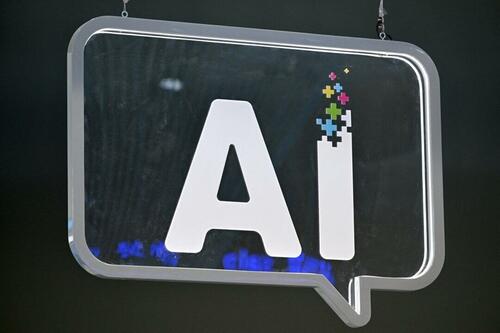
The AI Paradox
Authored by James Gorrie via The Epoch Times,
If the rush to adopt artificial intelligence (AI) seems familiar, it’s because we’ve seen this movie before. In the late nineties, organizations of all sizes, but especially large or enterprise-level businesses, struggled to make the transition from legacy functionality to digital transformation. As late as the COVID-19 pandemic and global lockdown in 2020, enterprise organizations were rushing to complete their digital transitions, particularly when it came to enabling and protecting widely distributed remote workers with home office operations, workflows, and compliance regulations.

What’s more, an AI arms race is well underway, as Microsoft, Apple, and other tech firms invest billions into AI products such as OpenAI. Everyone knows full well, or should, just how intense the race to dominate AI is at the global and corporate levels. It’s that transformative.
AI Altering Business Practices
There’s no question that AI is the next technological advancement that will fundamentally alter our way of life in the very near future, and perhaps for evermore. In fact, it already is and continues to do so. But in these early and heady AI days, there are practicality speed bumps, too.
For example, corporate executives and boards are encountering implementation and control roadblocks that are preventing their organizations from realizing more than just a fraction of AI potential, not to mention justifying the millions of dollars in spending that an enterprise-level AI deployment costs in streamlining their operations, optimizing workflow, harmonizing siloed divisions, and other organizational challenges that enterprise-level organizations struggle to handle well.
But that’s just the beginning of the challenges and risks that AI poses to even mid-size businesses as well as enterprise-level organizations.
The Risk to Privacy and Ethics
The promise of AI lies not only in its speed of data analytics but in its utter power to quickly access—and potentially abuse access—to personal information. Individuals’ private data are shielded by their legal right to privacy, and the responsibility to protect that privacy falls upon organizations that possess private data. If an AI-driven program or product is abused or even just not monitored, the risk of an enterprise finding itself in violation of privacy laws rises.
There’s also the risk of bias perpetuation and the resulting social impact of any biases that are baked into the AI program. These may well include the personal beliefs of the AI programmer or servicer, with outcomes that harm certain people with personal beliefs that are counter to those that are in the AI programming.
Unlawful surveillance is another risk that AI brings to organizations of all sizes. Do people have the right not to be surveilled when engaging in activities on their time? Do they have the right to their behavior not being commoditized with predictive analytics and sold to the marketplace repeatedly? They should, but in practice, it’s much more a case of technology outrunning our legal system’s ability to address the new challenges and risks. The risk of technological change and capabilities is just too fast.
Bias In AI
It’s worth examining the biases in AI a bit more closely. The adage “garbage in, garbage out” applies to the risks and impact of bias in AI as it’s applied to human beings and their individual beliefs, behaviors, and opinions. This also applies to business conduct standards, privacy concerns, and whatever other aspect of a business that can be assessed and valued—or devalued—by a subjective AI-driven process or program.
This is simply because AI is a product of its creator and, therefore, the creator’s biases. Objectivity is difficult, if not impossible, to obtain or communicate with regard to moral and ethical questions, the value of deliberation over speed, the often-complex processes of negotiation and compromise, or current benefit versus future benefits, market goodwill, and so forth.
AI Integration Risks and Challenges
In practical terms, many enterprises are finding that integrating AI into their current operations is difficult and disruptive. In many, if not most cases, organizational growth is both organic and organized, streamlined as well as siloed. That is, business practices and workflow nuances have evolved over time, often as a result of personality quirks, personal relationships within and outside of the organization, established business practices, and other “human factor” reasons why a business operates as it does.
The process of integrating AI-driven systems into such nuanced organizations and their workflows can not only be costly but also fundamentally alter the organization itself in such a way as to make it unrecognizable to its own workforce and/or executives. It can also result in expensive compliance violations. Such risks make costly integrations with weak results a justifiable fear among boards and executives.
Data Security in AI
One of the biggest risks of adopting AI-driven systems is the speed at which they can access all data across an enterprise. Not only are new cyberattacks enhanced by AI, but once inside a network, hackers are often able to access undefended machine-based or even human identities to quickly leverage a firm’s AI-driven system to accelerate attacks and uncover protected data, enhance data theft, and carry out ransomware attacks, all exponentially quicker.
In effect, attackers can now use enterprises’ AI-driven systems to aid in their own data loss before they even know they’ve been breached. AI is essentially a tool that does the work of whoever controls it. This was the case with Microsoft’s Copilot for Microsoft 365, where researchers used Copilot to quickly locate and exfiltrate critical data with just a few prompts, something that no hacker could ever do before.
Legal Risks
Given that we live in a highly litigious society, the risks that AI poses to enterprises are significant and challenging. The truth is that AI-driven programs, tools, and solutions will continue to be rapidly adopted. At the same time, the risks to intellectual property, and the liability that AI represents to organizations in terms of regulatory compliance, accountability, privacy, and ethical concerns won’t go away any time soon.
Businesses and organizations are rushing to bring on AI and deploy it as soon as possible, if for no other reason that they don’t want to be left behind. “Innovate or die,” after all, isn’t just an over-the-top saying; for many firms, it’s a statement of fact.
Artificial intelligence is inevitable, no matter what I write in this article. Before too long, AI will be monitoring organizations across the nation and around the world. That transformation will be much quicker than the prior digital revolution in the economy, which took up to 20 years.
But in all of this, one obvious question remains: “Who monitors AI?”
Tyler Durden
Thu, 09/05/2024 – 13:35
















